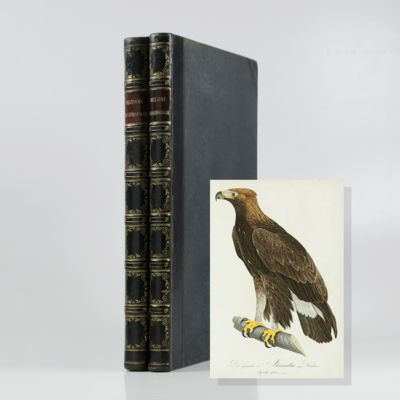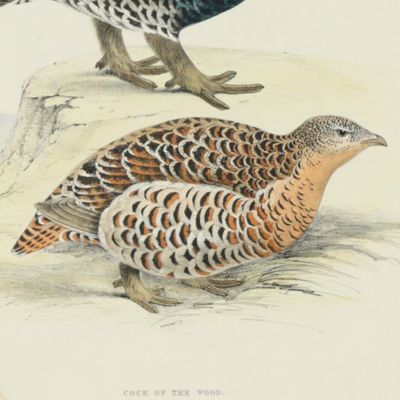The grandest bird book in the German language
[Susemihl, J. C.] Borkhausen, M. B.
Teutsche Ornithologie oder Naturgeschichte aller Vögel Teutschlands in naturgetreuden Abbildungen und Beschreibungen.
Published
1800-1841
Item ID
76667
€16,500.00
Darmstadt, 1800-1817-1841. In two parts. Folio (46.3 x 31.3 cm). 132 [67; 65] colour-printed plates, in careful, original hand-colouring, with accompanying descriptive text leaves in German, and, often, also in French. Uniform polished half calf over floral-patterned, embossed boards.
The major German bird book of the early 19th century; sometimes seen as a German answer to the several fine, large folio French bird books from that period, of which several were colour-printed too. It differs from its French peers in occasionally having several - up to four - different plates devoted to one species - showing male and/or female and/or juvenile specimens on different plates, and in having extremely large images, often truly dominating the plates. Originally published in 21 parts ("Hefte"), of which the last one was published in 1817, six years after the penultimate part. This last part is 'very rare' (Sitwell). Many copies lack the last six plates. A reprint "Neue Folge" was published in 1837-1841. The first volume is almost entirely devoted to birds of prey (eagles, falcons, owls). This book is variously attributed to Johann Conrad Susemihl (e.g., by Nissen), and - far more often - to Moritz Balthasar Borkhausen, or Borckhausen (e.g., Anker, Sitwell, Zimmer), or Borkhausen & Others (Cat. BM[NH]). Susemihl is in fact one of several artists, including his brother J. Th. Susemihl, and son, Eduard Susemihl. Sitwell lists Lichthammer, Bekker, Lembcke and Bekker Jun. as other authors, and ignores, ostentatiously, the Susemihls, merely mentioning them as artists. Borkhausen (1760-1806) wrote several works on zoology, and mainly entomology, for instance a Naturgeschichte der Europäischen Schmetterlinge nach systematischer Ordnung (1788-1794). Susemihl (1767-1847 or 1846) also made the plates to, e.g., Oken's Allgemeine Naturgeschichte für alle Stände. According to Anker, part 14 has an additional French text. This copy has seventeen French texts next to the German texts, as follows: Vol. I. Der Seeadler - L'orfraye; Der Wespenbussard - La bondrée; Der Zwergfalke - L'emerillon; Der Wanderfalke - Le faucon pelerin; Der gemeine Baumfalke - Le hobreau; Der Tannenfalke - Le faucon des sapins; Die kurzöhrige Ohreule - La chouette à courte oreille; Die grosse Krähe - Le corbeau. Vol. II. Der Nussheher - Le casse-noix; Der grosse graue Würger - La pie-grièche grise; Der rothköpfige Würger - La piegriêche à tête rousse; Der Goldammer - Le bruant; Der grüne Kernbeisser - Le verdier; Der schwartzkehlige Sänger - Le rossignol de muraille; Die Blaumeise - La mésange bleue; Die Haubenmeise - La mesange huppée; Die Knäckente - La sarcelle. French texts are not often mentioned. The text to the Dorndreher, or red-backed shrike, is not placed opposite the plate. Provenance: armorial bookplate of the Anglo-British botanist and ornithologist Henry Rogers Broughton, 2nd Baron Fairhaven (1900-1973), mounted on the front pastedown. Scattered spotting to the text, rather strong on a few leaves; the plates usually much cleaner, often without spotting or just some isolated, marginal spots.
read more
The title page is missing, as in many copies (see, e.g., Anker and Zimmer). Sometimes - but not here - one of the original wrappers to a part is used as a substitute. Very rare. Anker describes an incomplete copy (first 18 parts, 1800-1809). Anker, 52 [under Borkhausen]; Cat. BM(NH), p. 202; Nissen IVB, 907; Sitwell, Fine Bird Books, p. 79; Zimmer, p. 81 [under Borckhausen].
read less





